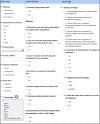Direct Observation Assessment of Ultrasound Competency Using a Mobile Standardized Direct Observation Tool Application With Comparison to Asynchronous Quality Assurance Evaluation
- PMID: 31008429
- PMCID: PMC6457355
- DOI: 10.1002/aet2.10324
Direct Observation Assessment of Ultrasound Competency Using a Mobile Standardized Direct Observation Tool Application With Comparison to Asynchronous Quality Assurance Evaluation
Abstract
Objectives: Competency assessment is a key component of point-of-care ultrasound (POCUS) training. The purpose of this study was to design a smartphone-based standardized direct observation tool (SDOT) and to compare a faculty-observed competency assessment at the bedside with a blinded reference standard assessment in the quality assurance (QA) review of ultrasound images.
Methods: In this prospective, observational study, an SDOT was created using SurveyMonkey containing specific scoring and evaluation items based on the Council of Emergency Medicine Residency-Academy of Emergency Ultrasound: Consensus Document for the Emergency Ultrasound Milestone Project. Ultrasound faculty used the mobile phone-based data collection tool as an SDOT at the bedside when students, residents, and fellows were performing one of eight core POCUS examinations. Data recorded included demographic data, examination-specific data, and overall quality measures (on a scale of 1-5, with 3 and above being defined as adequate for clinical decision making), as well as interpretation and clinical knowledge. The POCUS examination itself was recorded and uploaded to QPath, a HIPAA-compliant ultrasound archive. Each examination was later reviewed by another faculty blinded to the result of the bedside evaluation. The agreement of examinations scored adequate (3 and above) in the two evaluation methods was the primary outcome.
Results: A total of 163 direct observation evaluations were collected from 23 EM residents (93 SDOTs [57%]), 14 students (51 SDOTs [31%]), and four fellows (19 SDOTs [12%]). The trainees were evaluated on completing cardiac (54 [33%]), focused assessment with sonography for trauma (34 [21%]), biliary (25 [15%]), aorta (18 [11%]), renal (12 [7%]), pelvis (eight [5%]), deep vein thrombosis (seven [4%]), and lung scan (5 [3%]). Overall, the number of observed agreements between bedside and QA assessments was 81 (87.1% of the observations) for evaluating the quality of images (scores 1 and 2 vs. scores 3, 4, and 5). The strength of agreement is considered to be "fair" (κ = 0.251 and 95% confidence interval [CI] = 0.02-0.48). Further agreement assessment demonstrated a fair agreement for images taken by residents and students and a "perfect" agreement in images taken by fellows. Overall, a "moderate" inter-rater agreement was found in 79.1% for the accuracy of interpretation of POCUS scan (e.g., true positive, false negative) during QA and bedside evaluation (κ = 0.48, 95% CI = 0.34-0.63). Faculty at the bedside and QA assessment reached a moderate agreement on interpretations noted by residents and students and a "good" agreement on fellows' scans.
Conclusion: Using a bedside SDOT through a mobile SurveyMonkey platform facilitates assessment of competency in emergency ultrasound learners and correlates well with traditional competency evaluation by asynchronous weekly image review QA.
Figures


Similar articles
-
Real-time inter-rater reliability of the Council of Emergency Medicine residency directors standardized direct observation assessment tool.Acad Emerg Med. 2009 Dec;16 Suppl 2:S51-7. doi: 10.1111/j.1553-2712.2009.00593.x. Acad Emerg Med. 2009. PMID: 20053212
-
Standardized Direct Observation Assessment Tool: Using a Training Video.J Emerg Med. 2017 Apr;52(4):530-537. doi: 10.1016/j.jemermed.2016.12.002. Epub 2017 Jan 19. J Emerg Med. 2017. PMID: 28111067
-
Can You Teach Yourself Point-of-care Ultrasound to a Level of Clinical Competency? Evaluation of a Self-directed Simulation-based Training Program.Cureus. 2018 Sep 17;10(9):e3320. doi: 10.7759/cureus.3320. Cureus. 2018. PMID: 30473953 Free PMC article.
-
Evaluation of Trainee Competency with Point-of-Care Ultrasonography (POCUS): a Conceptual Framework and Review of Existing Assessments.J Gen Intern Med. 2019 Jun;34(6):1025-1031. doi: 10.1007/s11606-019-04945-4. J Gen Intern Med. 2019. PMID: 30924088 Free PMC article. Review.
-
Perioperative Point of Care Ultrasound (POCUS) for Anesthesiologists: an Overview.Curr Pain Headache Rep. 2020 Mar 21;24(5):20. doi: 10.1007/s11916-020-0847-0. Curr Pain Headache Rep. 2020. PMID: 32200432 Review.
Cited by
-
A Tool to Assess Competence in Critical Care Ultrasound Based on Entrustable Professional Activities.ATS Sch. 2023 Jan 24;4(1):61-75. doi: 10.34197/ats-scholar.2022-0063OC. eCollection 2023 Mar. ATS Sch. 2023. PMID: 37089679 Free PMC article.
-
A comparison of handheld ultrasound versus traditional ultrasound for acquisition of RUSH views in healthy volunteers.J Am Coll Emerg Physicians Open. 2020 Nov 21;1(6):1320-1325. doi: 10.1002/emp2.12322. eCollection 2020 Dec. J Am Coll Emerg Physicians Open. 2020. PMID: 33392539 Free PMC article.
-
Current Use, Perceived Barriers, and Learning Preference of Point of Care Ultrasound (POCUS) in the Emergency Medicine in Qatar - A Mixed Design.Open Access Emerg Med. 2021 May 18;13:177-182. doi: 10.2147/OAEM.S304153. eCollection 2021. Open Access Emerg Med. 2021. PMID: 34040459 Free PMC article.
-
Tools for Measuring Clinical Ultrasound Competency: Recommendations From the Ultrasound Competency Work Group.AEM Educ Train. 2019 Jul 30;4(Suppl 1):S106-S112. doi: 10.1002/aet2.10368. eCollection 2020 Feb. AEM Educ Train. 2019. PMID: 32072114 Free PMC article.
-
The ultrasound competency assessment tool for four-view cardiac POCUS.Ultrasound J. 2021 Sep 27;13(1):42. doi: 10.1186/s13089-021-00237-3. Ultrasound J. 2021. PMID: 34570287 Free PMC article.
References
-
- Counselman FL, Borenstein MA, Chisholm CD, et al. The 2013 Model of the Clinical Practice of Emergency Medicine. Acad Emerg Med 2014;21:574–98. - PubMed
-
- Mateer J, Plummer D, Heller M, et al. Model curriculum for physician training in emergency ultrasonography. Ann Emerg Med 1994;23:95–102. - PubMed
-
- American College of Emergency Physicians . Use of ultrasound imaging by emergency physicians. Ann Emerg Med 2001;38(4 Suppl):469–70. - PubMed
-
- American College of Emergency Physicians . Emergency ultrasound guidelines. Ann Emerg Med 2009;53:550–70. - PubMed
-
- American College of Emergency Physicians . Ultrasound guidelines: emergency, point‐of‐care and clinical ultrasound guidelines in medicine. Ann Emerg Med 2017;69:e27–e54. - PubMed
LinkOut - more resources
Full Text Sources

